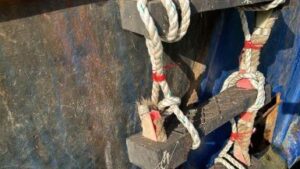
Tokyo MOU has reinforced an awareness of the potential risks associated with the improper maintenance and rigging of pilot transfer arrangements. Therefore they released a guidance on maintenance and rigging of pilot transfer.
Tokyo MOU has reported that recent reports and Port State Control (PSC) inspections have highlighted recurring issues related to pilot ladders and hoist/pilot transfer arrangements, the improper rigging of pilot transfer arrangements.
In 2020, there were 197 deficiencies, and 1 detention related to pilot transfer arrangements. By 2024, these numbers had risen sharply to 523 deficiencies and 12 detentions. This significant increase is a cause for concern and underscores the urgent need for ship’s crew and operators to take prompt corrective action.
Despite previous safety bulletins addressing concerns such as the use of D-shackles for securing the pilot ladders, several other issues continue to persist.
These include:
- Failure to properly secure pilot ladders and accommodation ladders to the ship’s side
- Inadequate securing of stanchions with locking pins
- General complacency regarding ladder maintenance
- Lack of clear identification and differentiation between pilot ladders and other types of ladders
These repeated issues suggest a need for improved crew training and awareness regarding pilot ladders and pilot transfer arrangements. Separately, a Focused Inspection Campaign (FIC) was also carried out by the Tokyo MOU member Authorities in February 2025 on Pilot Ladders/Pilot Transfer Arrangements. During the campaign period, a total of 2,357 inspections were conducted. Three ships were detained and 176 deficiencies related to the FIC were identified on 169 ships.
Regulatory Requirements
The requirements for pilot transfer arrangements are outlined in SOLAS Chapter V, Regulation 23 and supporting standards, including:
- IMO MSC.1/Circ.1331 – Guidelines for pilot transfer arrangements
- IMO RES. A.1045(27) – Recommendation on pilot transfer arrangements
- ISO 799-1:2019 – Standard for pilot ladder construction and specifications
- According to SOLAS V/23.3.3.1, a pilot ladder must be used when a pilot is required to climb between 1.5 to 9.0 metres. The regulation mandates specific design, construction, and certification standards for pilot ladders.
Crew Training, Familiarisation and Responsibilities
Pilot ladders are uniquely constructed in accordance with SOLAS/ISO standards and include features such as spreaders for safety. It is essential that all crew members:
- Understand how to identify pilot ladders from other types of ladders
- Are familiar with proper rigging procedures in line with SOLAS and IMO/ISO guidelines
- Conduct regular checks and maintenance to ensure equipment integrity
- Remain vigilant and proactive to avoid complacency in safety-critical tasks
The ISM company should ensure that risks, control measures, safety procedures, training and maintenance provisions of pilot ladder and pilot ladder transfer arrangement are documented in their Safety Management System, and Planned Maintenance System and effectively implemented consistently across the fleet.
Flag States and/or the Recognised Organisations should ensure that during surveys and inspections, pilot transfer arrangements are surveyed/inspected, which includes ensuring crew are sufficiently familiar with the rigging the pilot transfer arrangement. Required Pilot Transfer Arrangement Poster (IMPA) – Annex II (a). Pictorial representation of the required boarding arrangements for pilot in accordance with SOLAS Regulation V/23 & IMO Res. A. 1045(27) – Annex III.
Recommended Actions: Ensuring Safe Pilot Transfer Arrangements
To enhance safety and prevent accidents related to pilot transfer, shipowners, operators, master and crew of vessels are strongly advised to take the following steps:
- Conduct Physical Checks Verify the current method of securing pilot ladders to ensure there are no rigging errors or lapses in safety.
- Perform Regular Maintenance and Training Carry out routine maintenance of pilot ladders and conduct regular crew training on proper rigging procedures.
- Seek Guidance When in Doubt If there is any uncertainty regarding compliance or procedures, consult the Flag Administration, Recognised Organisations (ROs), or your company for clarification and direction.
- Prioritise Safe Rigging Practices Ultimately, it is the responsibility of the ship owners, operators, Masters & crew to ensure that the pilot transfer arrangement is rigged safely and securely for the safety of all users.
- Replace unfit / damaged pilot ladders Damaged or otherwise unsafe pilot ladders must not be used, be taken out of service immediately and replaced with a new ladder meeting the requirements of SOLAS Ch V, Regulation 23.
Read the bulletin in full: Tokyo MOU Safety Bulletin 02-2025